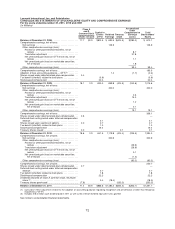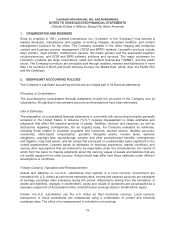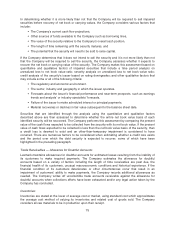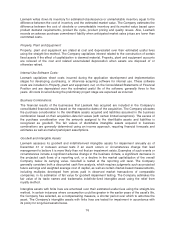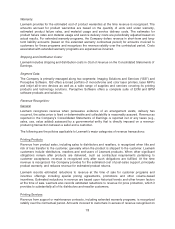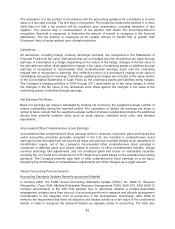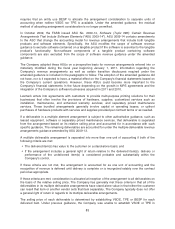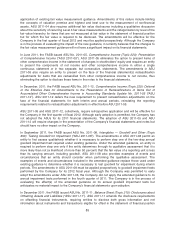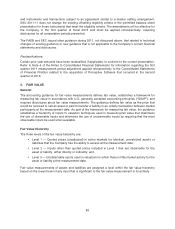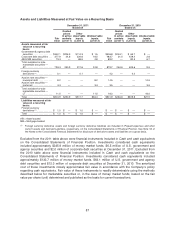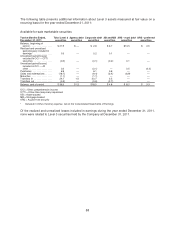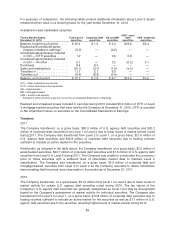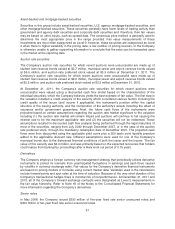Lexmark 2011 Annual Report Download - page 86
Download and view the complete annual report
Please find page 86 of the 2011 Lexmark annual report below. You can navigate through the pages in the report by either clicking on the pages listed below, or by using the keyword search tool below to find specific information within the annual report.
The evaluation of a tax position in accordance with the accounting guidance for uncertainty in income
taxes is a two-step process. The first step is recognition: The enterprise determines whether it is more
likely than not that a tax position will be sustained upon examination, including resolution of any
litigation. The second step is measurement: A tax position that meets the more-likely-than-not
recognition threshold is measured to determine the amount of benefit to recognize in the financial
statements. The tax position is measured at the largest amount of benefit that is greater than
50 percent likely of being realized upon ultimate resolution.
Derivatives:
All derivatives, including foreign currency exchange contracts, are recognized in the Statements of
Financial Position at fair value. Derivatives that are not hedges must be recorded at fair value through
earnings. If a derivative is a hedge, depending on the nature of the hedge, changes in the fair value of
the derivative are either offset against the change in fair value of underlying assets or liabilities through
earnings or recognized in Accumulated other comprehensive earnings (loss) until the underlying
hedged item is recognized in earnings. Any ineffective portion of a derivative’s change in fair value is
immediately recognized in earnings. Derivatives qualifying as hedges are included in the same section
of the Consolidated Statements of Cash Flows as the underlying assets and liabilities being hedged.
The Company’s hedging activities in 2009 through 2011 were made up of fair value hedges in which
the changes in the fair value of the derivatives were offset against the changes in fair value of the
underlying assets or liabilities through earnings.
Net Earnings Per Share:
Basic net earnings per share is calculated by dividing net income by the weighted average number of
shares outstanding during the reported period. The calculation of diluted net earnings per share is
similar to basic, except that the weighted average number of shares outstanding includes the additional
dilution from potential common stock such as stock options, restricted stock units, and dividend
equivalents.
Accumulated Other Comprehensive (Loss) Earnings:
Accumulated other comprehensive (loss) earnings refers to revenues, expenses, gains and losses that
under accounting principles generally accepted in the U.S. are included in comprehensive (loss)
earnings but are excluded from net income as these amounts are recorded directly as an adjustment to
stockholders’ equity, net of tax. Lexmark’s Accumulated other comprehensive (loss) earnings is
composed of deferred gains and losses related to pension or other postretirement benefits, foreign
currency exchange rate adjustments, and net unrealized gains and losses on marketable securities
including the non-credit loss component of OTTI beginning in 2009 based on the amended accounting
guidance. The Company presents each item of other comprehensive (loss) earnings on a net basis,
displaying the combination of reclassification adjustments and other changes as a single amount.
Recent Accounting Pronouncements:
Accounting Standards Updates Recently Issued and Adopted
In October 2009, the FASB issued Accounting Standards Update (“ASU”) No. 2009-13, Revenue
Recognition (Topic 605): Multiple-Deliverable Revenue Arrangements (“ASU 2009-13”). ASU 2009-13
contains amendments to the ASC that address how to determine whether a multiple-deliverable
arrangement contains more than one unit of accounting and how to measure and allocate arrangement
consideration to the separate units of accounting in the arrangement. Specifically, ASU 2009-13
removes the requirement that there be objective and reliable evidence of fair value of the undelivered
item(s) in order to recognize the delivered item(s) as separate unit(s) of accounting. The ASU also
82


